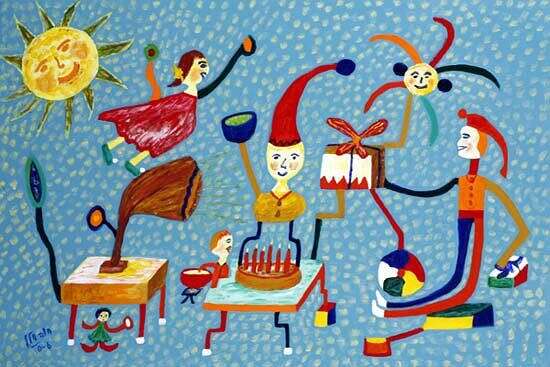Hava Wolf went through seven rounds of hell, and for many years fought to display her paintings in a museum • "I am here, but still there, trapped in the Holocaust, I began to paint pictures about the lost childhood"
Holocaust survivor Hava Wolf passed away this week at the age of 88. In recent years, Wolf's frustration with the Yad Vashem Holocaust Museum, which refused to display her paintings within its walls due to their colorfulness and, as a result, were "less suitable" for the museum.
Wolf had serious allegations against the Holocaust memorial institutions, which she claimed did not sufficiently expose the Holocaust of the Romanian Jewish community.
Hava Wolf-Wiesnitzer was born in Romania to an established and educated family.
For four years she went through seven sections of hell in the Transnistria camp, contracted typhus and pneumonia and suffered hunger and frost of 42 degrees below zero.
Wolf's difficult experiences began when she was only eight years old.
"At the age of eight, all my dreams were taken from me," she wrote in her book, "Childhood in the Tangle of Tears."
Regarding the expulsion of her family from Viznitz, she said: "We were about to leave the house, a Romanian soldier was standing in the doorway. My father had a lantern in his hand. "Back to the apartment. To this day, I feel my father's insult, the humiliation."
"We were crammed into a car with no air to breathe and no water," she said.
"There were very many people in the caravan, including children and the elderly. The torture of the trip was unbearable ... The passengers of the train were taken to a large field ... Thousands of people and children sat on the packages destroying their lives."
Wolf and her family arrived in Kopeigrod, a neglected village where the Jews in the ghetto were gathered.
"We were given a small room, in which eighteen people lived. It was crowded, it was a hard winter, 42 degrees. People froze and died like flies. I would stand and watch the frozen people being thrown to death, like logs on the carts that came to pick them up."
Instead, typhoid and dysentery began to rage.
Wolf herself has twice had typhus, dysentery and pneumonia.
As punishment for failing to persevere in the sweeping, Wolfh received a severe blow to the head.
"The head swelled and filled with pus, the swelling also passed to the face and my vision was impaired.
"In the situation I was in, the deportation came to the forest, on foot, about five kilometers from the village. All the people dispersed to find accommodation, I could not walk and started crawling on the ground. "The wound in my head and also deaf as a result of the climbing disease. I sat down, leaned on a tree trunk and cried. People passed me without addressing my cries, for everyone it was hell on earth."
Luckily for Wolf, one of the women who passed by recognized her and collected her, and later even managed to reunite with her family.
"In the forest there was a large structure, full of people, most of them sick. We chose to stay outside, in the rain and frost. My late father cut trees and made them a tent, which would protect us a little from the wind.
We had neither food nor water, "she wrote in her book. Wolf further describes the difficult life in the forest, the German bombings, the famine and the cold.
At the end of the war, he returned to Radayot and rented an apartment there.
In 1947 she immigrated to Israel with the youth aliyah as a lone girl.
She married, had three daughters, and grandchildren and great-grandchildren.
In her last years, Wolf began to paint and sculpt, with the severe trauma of the Holocaust in front of her eyes.
The walls of her humble home are covered with pictures she painted in bright, pastel colors, and in a conversation with her she knew how to explain how each picture relates to the difficult childhood she experienced in the shadow of the Holocaust.
Her pictures are incorporated in her book, "Childhood in the Tangle of Tears."
"I am here, but still there, trapped in the Holocaust. The pain and memories are now waking up even more," she wrote in her book.
"I began to write songs in memory of the Holocaust in tears, and to paint pictures about the lost childhood and the optimism and desire for life. I hope that whoever sees my paintings and reads my poems will understand and feel what I went through in the Holocaust. I miraculously survived.
In the living room of her home you can still find pictures with former IDF officials, and a binder with a letter of thanks and appreciation that she devoutly kept. .
One of her wishes was to give one of her works to the President of the State, Reuven (Ruby) Rivlin.
Unfortunately, she will no longer get it.

